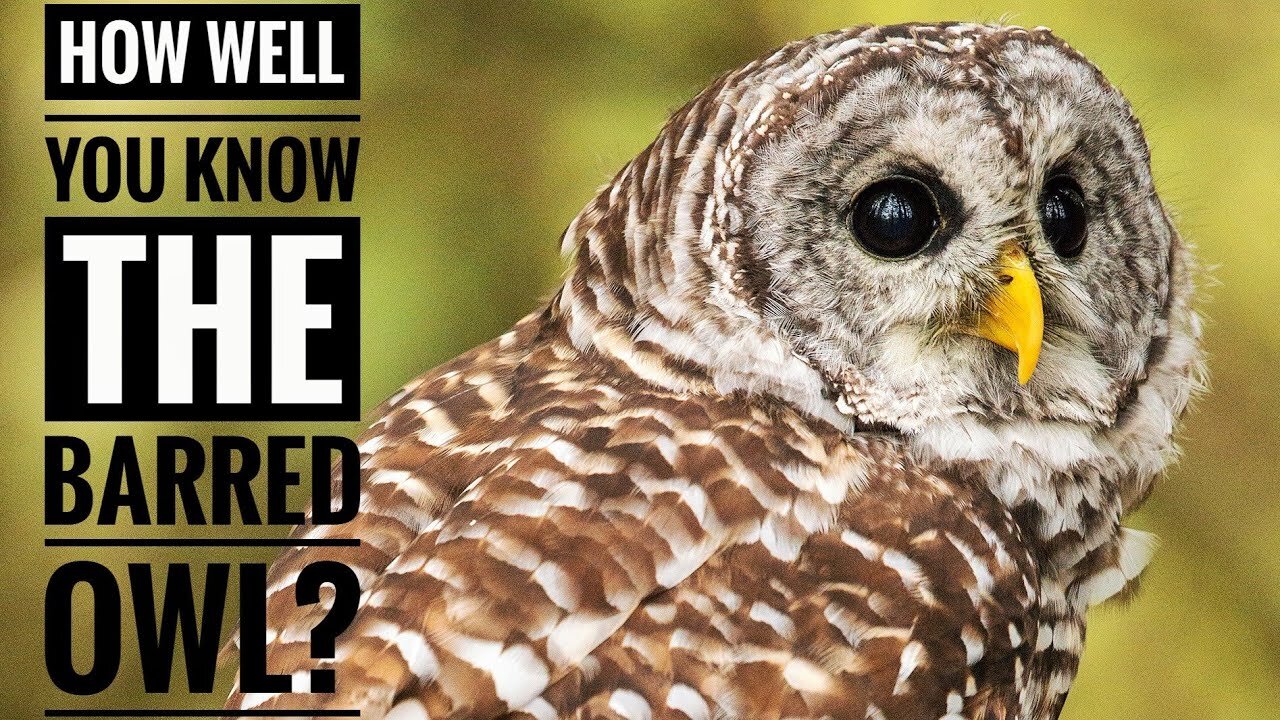Premium Only Content

Barred Owl || Description, Characteristics and Facts!
Barred Owl Description:
The Barred Owl (Strix varia) is a striking and charismatic bird of prey native to North America. Recognized for its distinctive appearance and haunting vocalizations, this medium-sized owl is a captivating species.
Characteristics:
Plumage: The Barred Owl features a distinctive barred pattern on its feathers, consisting of alternating dark and light bands, which provides excellent camouflage in its woodland habitat.
Size: With a wingspan of around 3.3 to 3.8 feet (1 to 1.2 meters) and a length of 16 to 25 inches (40 to 63 centimeters), the Barred Owl is a medium-sized owl.
Facial Disk: Its facial disk, a defining characteristic of owls, aids in sound localization during hunting. The facial disk is framed by a ruff of feathers, adding to the owl's overall allure.
Eyes: Large, dark brown eyes contribute to its keen nocturnal vision, allowing it to hunt effectively in low-light conditions.
Habitat: Barred Owls are adaptable and can be found in various wooded environments, including forests, swamps, and urban areas, demonstrating their versatility in habitat selection.
Diet: These owls are opportunistic hunters, preying on small mammals like mice, voles, and rabbits. They are also known to consume birds, amphibians, and invertebrates.
Vocalizations: The Barred Owl is famous for its distinctive hooting calls, often described as sounding like, "Who cooks for you? Who cooks for you all?" These vocalizations are a prominent feature of their communication.
Facts:
Barred Owls do not build their own nests. They typically utilize abandoned nests of other large birds or natural tree cavities.
These owls are known for their territorial nature and may exhibit aggressive behavior when defending their nesting sites.
Barred Owls are skilled in silent flight, thanks to the specialized structure of their feathers that reduces noise during flight, aiding them in surprising their prey.
They are capable of turning their heads up to 270 degrees due to their flexible neck structure, allowing for an extensive field of vision.
Hashtags:
#BarredOwl #BirdsOfPrey #WildlifeWednesday #NaturePhotography #OwlLovers #NocturnalWonders #Birdwatching #Conservation #HootHoot #NatureFacts
-

AimControllers
2 hours ago $0.12 earned🔴LIVE - TRIVIA NIGHT WITH PRIZES COME PLAY!
11.8K1 -
 1:45:13
1:45:13
RiftTV
4 hours agoLast Catholic Church in Gaza DESTROYED, Targeted by IDF? | The Rift | with Sarah Stock & Anna Perez
36.9K18 -
 LIVE
LIVE
PudgeTV
3 hours ago🟢PEAK - Gaming on Rumble | Community Gaming Night
83 watching -
 LIVE
LIVE
Precision Rifle Network
1 day agoS4E23 Guns & Grub - Gear We H8, Politics, & New Optics
109 watching -
 LIVE
LIVE
FatHeadedNoob
2 hours agoStaying In My Lane | Trying Bleak Haven Demo
29 watching -
 18:55
18:55
Tundra Tactical
7 hours ago $0.04 earnedGun Show Weirdos
312 -
 LIVE
LIVE
OVERKLOC
2 hours ago🔴LIVE - AMONG THE SLEEP - CHAT ASKS... CHAT GETS
6 watching -
 3:12:54
3:12:54
Chrono
4 hours agoGoing Bananza! | Donkey Kong Bananza
66 -
 LIVE
LIVE
Hernandez2787
2 hours agoLet's play Arena Breakout for 2nd time.
8 watching -
 LIVE
LIVE
AirCondaTv Gaming
4 hours ago $0.02 earnedCursed Companions - JFG has Never Had a More Cursed Companion than I! (collab)
24 watching